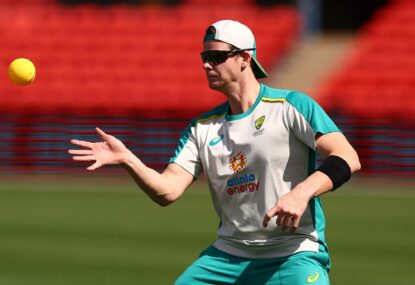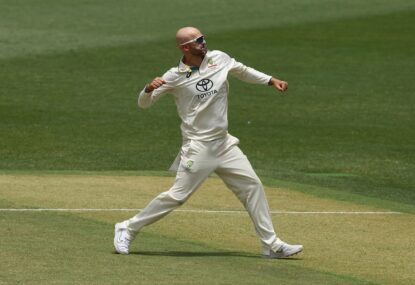The first half of the 2010s was a messy period for the domestic one-day game, to say the least.
Rules and formats were thrown around to try and stem a decline in the competition’s popularity and relevance. Games per season varied between 31 in 2010/11 down to 20 in 2013/14 and back up to 23. A CAXI consisting of fringe state players was briefly included from 2015/16.
The competition trialled allowing bowlers to bowl a maximum of 12 or 13 overs, before reverting back to the traditional 10. In the 2010/11 season, they even reduced all games to 45 overs per side and split each side’s innings into alternating 20 and 25-over blocks.
QLD and NSW shared the spoils during this era with two titles each, although NSW were also runners-up twice. Between 2013/14 and 2016/17 they reached four consecutive finals.
South Australia had a rare win in 2011/12, their first in 25 years. This was achieved via a tie with Tasmania and the trophy being handed to the Redbacks courtesy of a higher regular season ladder position. After winning three titles during the noughties, Tasmania have not troubled the scorers since 2009/10.
Cameron White (VIC) won consecutive player of the series awards in 2013/14 and 2014/15. Others to receive the award were: Brad Hodge (VIC), Tom Cooper (SA), Aaron Finch (VIC), Mitchell Starc (NSW) and Marnus Labuschagne (QLD)
Year by Year
In 2010/11 Victoria enjoyed a dominant season, losing only two of ten matches. They comfortably accounted for Tasmania in a rain-affect final by 84 runs. Player of the series, Brad Hodge top scored with 61 as Victoria reached 194 from their 38 overs, despite Tasmania’s James Faulkner taking four wickets for just 20 runs.
In response Tasmania folded for only 109, losing three wickets each to player of the match Dirk Nannes and to Mark Cleary. Only Ed Cowan, who arrived in the third over and batted through for 32 not out, provided any resistance.
Most series runs: Brad Hodge (VIC) 560. Most Series wickets: Brendan Drew (TAS) 19.
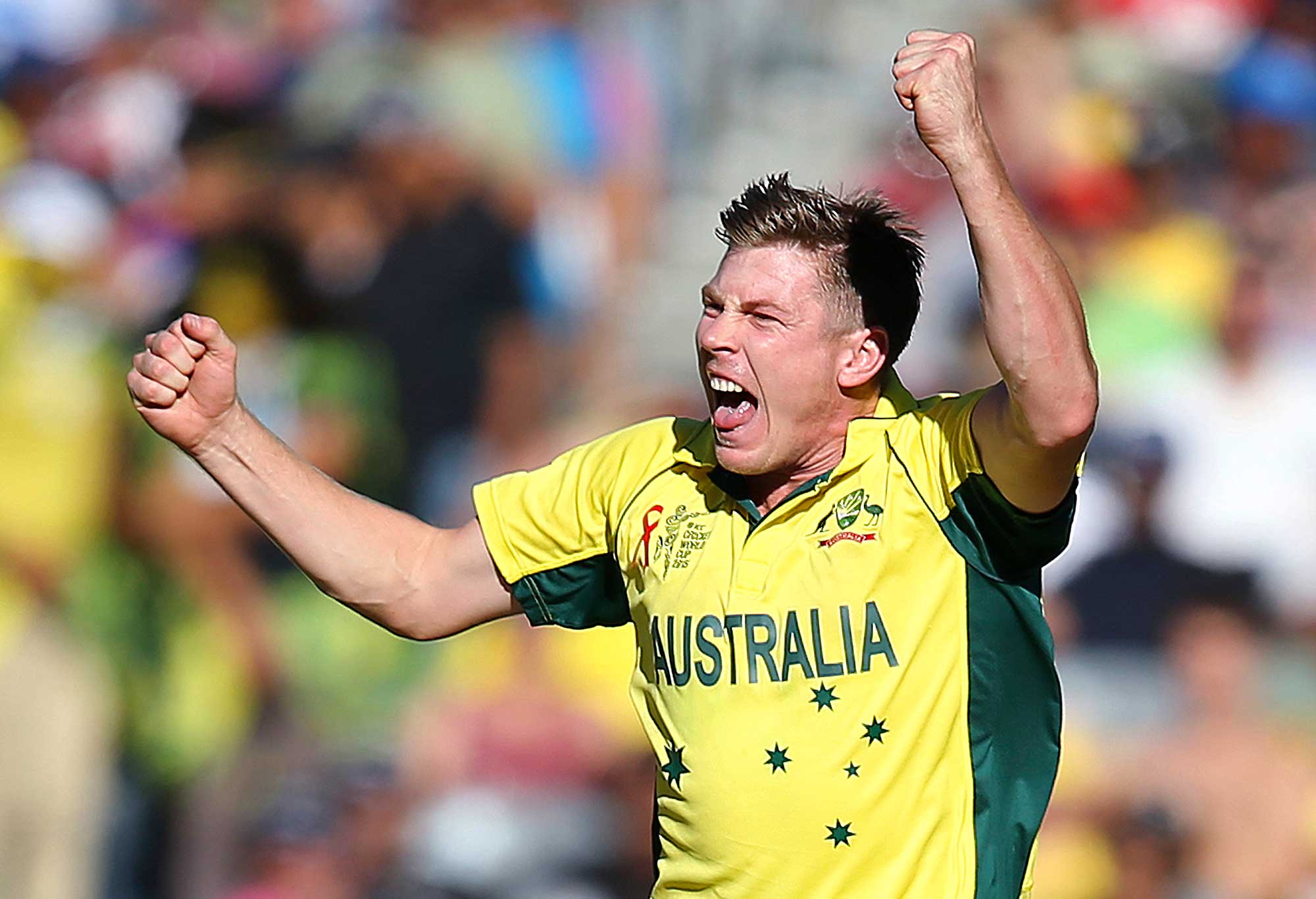
Australia’s James Faulkner celebrates taking a wicket. (AP Photo/Rick Rycroft)
2011/12 was a remarkable year, with SA and Tasmania playing out the first-ever tied final. SA were awarded the trophy in a countback. Despite both teams having a 6-2 win-loss record for the season, SA had received one single additional bonus point compared to Tasmania and that was enough to clinch the title.
In the final, SA set a stiff target of 285 thanks to a 133-run opening stand between Michael Klinger (81) and Daniel Harris (60). James Faulkner took four wickets in a final for the second year in a row, but this time conceded 75 runs doing it. The chase was led firstly by Mark Cosgrove (69) and then by George Bailey (101 – Player of the Match) and Ricky Ponting (75 not out). With Ponting and Bailey at the crease Tasmania only needed 5 from the final over.
SA’s Gary Putland pinned Bailey LBW and noted finisher James Faulkner arrived needing just four from four balls and then two from three balls. Putland finished with dot, dot and Tasmania scrambled a bye to tie the game on the final ball.
Player of the series: Tom Cooper (SA). Most series runs: Michael Klinger (SA) 498. Most series wickets: Alistair McDermott (QLD) 16.
QLD won a nail-biter in 2012/13, defeating Victoria by just two runs in a rain-shortened 32-over match. QLD struggled to 146 thanks to a late flurry from Jason Floros (47 from 32 balls) when no one else could even score at a run-a-ball. Victoria in response were bowled out in the final over as player of the match Ryan Harris took two wickets in two balls to finish with 4/26.
Player of the series and most series runs: Aaron Finch (VIC) 504. Most series wickets: Kane Richardson (SA) 21.
QLD went back to back in 2013/14, this time chasing down NSW’s huge 317 with five balls to spare and five wickets in hand. Well, it was not really a huge total because the final was played at North Sydney Oval where the boundaries are tiny. This was the first year of the ‘carnival’ style series, all on suburban grounds and all done and dusted by the end of October.
Usman Khawaja was named player of the match in the final for his composed 104 from 100 balls, but it was a seventh-wicket partnership of 62 from just 35 balls between noted hitters Chris Lynn (58 from 40) and Ben Cutting (41 from 21) that sealed the match.
The competition staged an elimination final in 2013/14 for the first time since 1999/2000. This match was also an epic chase, with NSW running down Victoria’s total of 321 down with three balls to spare, thanks to a truly mammoth 197 from 141 balls from David Warner. Warner’s effort was the highest score in the competition’s history, taking the record set by QLD’s Jimmy Maher of 187 set way back in 2004. In contrast, Warner’s mark would last less than 12 months, as huge scores became more common.
Player of the series: Cameron White (VIC). Most series runs: David Warner (NSW) 541. Most series wickets: Sean Abbott (NSW) 16.
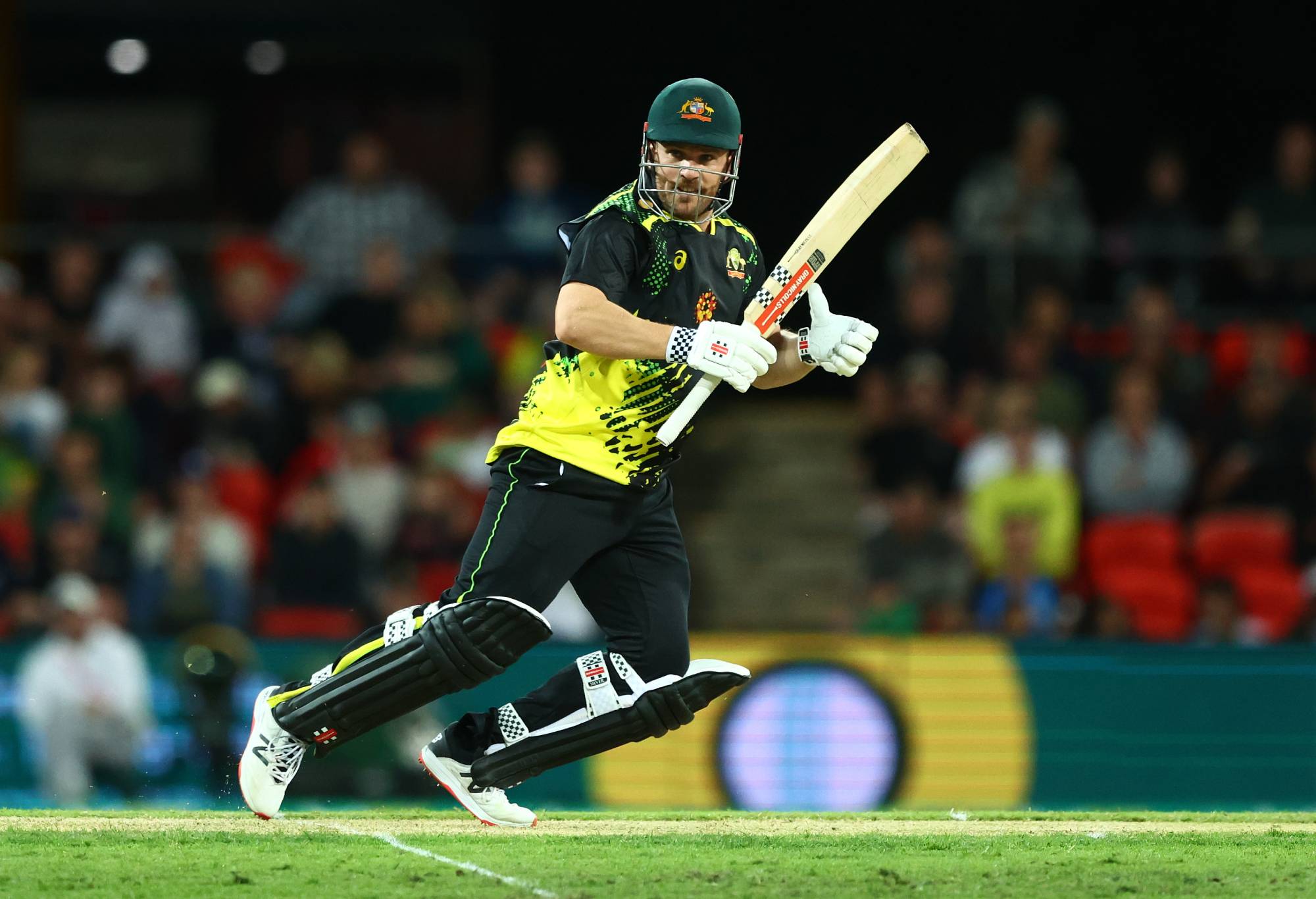
(Photo by Chris Hyde/Getty Images)
Victoria’s Cameron White won his second consecutive player of the series award in 2014/15, however it was WA who won the title for the first time in over a decade, defeating NSW in the final by 64 runs. WA set NSW a middling target of 255 thanks to a patient 96 from Michael Klinger, up against an attack including Doug Bollinger, Josh Hazlewood, Pat Cummins and Sean Abbott. It proved to be more than enough, even after losing Joel Paris to injury in only his second over. Jason Behrendorff took five wickets for just 27 runs and only Shane Watson’s 83 prevented a total rout.
In the Elimination Final, NSW’s attack had restricted QLD to just 225, but their shaky batting only just got them over the line, eight wickets down and in the final over, thanks to a quick-fire 31 from 21 balls from Pat Cummins.
Most series runs: Usman Khawaja (QLD) 523. Most series wickets: Gurinda Sandhu (NSW) 15.
In 2015/16, NSW won their first title in a decade, absolutely smashing SA in the final by nine wickets with 121 balls to spare. NSW played most of their internationals that season, including in the final, and Mitchell Starc, Josh Hazlewood (player of the match) and Steve Smith made significant contributions to the win. SA had previously knocked Victoria out in the Elimination Final, defending 250.
This year also saw the short-lived introduction of a Cricket Australia XI side, made up of fringe state players. The side included such future state players as Marcus Harris, Jack Wildermuth and Beau Webster. Nevertheless, after collecting three wooden spoons in a row, the experiment was quietly shelved.
NSW’s Mitchell Starc was only the second bowler to win Player of the Series, his 26 wickets setting a new series record. Most series runs: Steve Smith (NSW) 435.
NSW won their 2nd consecutive title in 2016/17, helped by another home season. This time QLD, who had set the pace for the series, were toppled for just 186 thanks to an amazing spell of four wickets for 10 runs from 10 overs by test spinner Nathan Lyon. NSW were never really troubled despite losing three quick top-order wickets to the admirable Michael Neser, winning by six wickets. NSW had reached the final by eliminating Victoria, who finished third for the second season running.
Player of the series: Marnus Labuschagne (QLD). Most series runs: Cameron White (VIC) 457. Most series wickets: Cameron Valente (SA), Pat Cummins (NSW) and Doug Bollinger (NSW) 15.
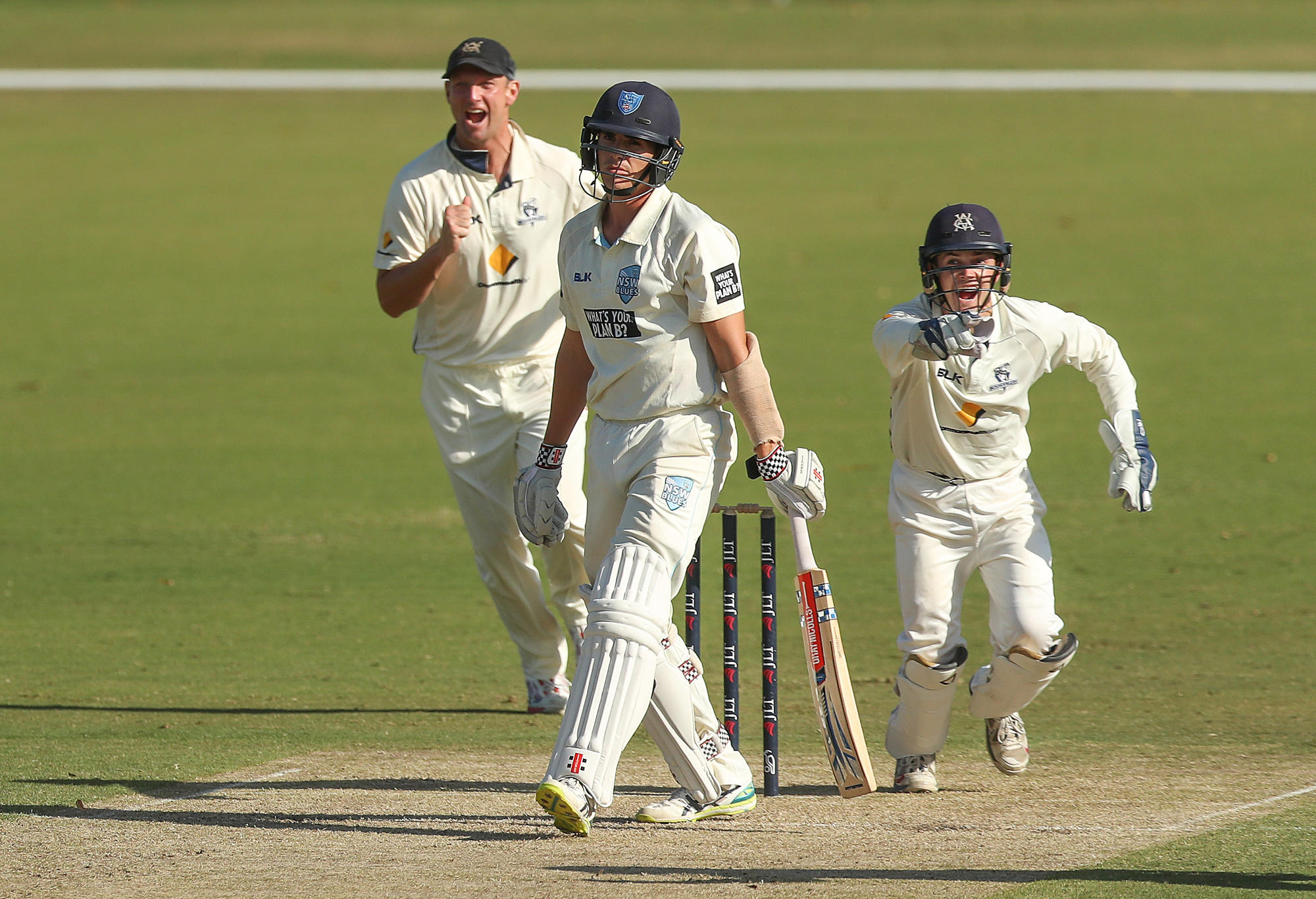
Sean Abbott of the NSW Blues reacts after he is out and the VIC Bushrangers celebrate during day one of the Sheffield Shield match between Victoria and New South Wales at Junction Oval on March 3, 2018 in Melbourne, Australia. (Photo by Kelly Defina/Getty Images)
Other Stand-out performances
2010/11
Brad Hodge (VIC) vs QLD in Brisbane. Set 239 to win, Hodge scored 140 not out from 121 balls as Victoria limped home eight wickets down, with no one else scoring over 26.
2011/12
Luke Ronchi (WA) vs SA in Adelaide and Perth.
WA were struggling at 5 for 67 after 18 overs, when Ronchi strode to the crease. He proceeded to wallop 113 from just 101 balls to drag WA to 7 for 233, with no other batsmen passing 26. Unfortunately for Ronchi, he was trumped by Callum Ferguson’s 110 not out as SA reached the target with two wickets to spare. History repeated later in the season in Perth – WA 5/103. Ronchi scored 103 from 80 balls, but SA got home thanks again to an unbeaten half-century from Callum Ferguson.
Daniel Smith (NSW) vs Victoria in Sydney.
Set a mammoth 318 to win (thanks to 144 from Brad Hodge and 91 from 57 balls by Rob Quiney), NSW cantered home in just 40 overs thanks to Smith’s 179 not out from just 122 balls, including 11 sixes.
Ben Laughlin (TAS) vs NSW in Canberra.
Tasmania struggled to 188 all out against a powerful NSW attack, with last man Laughlin contributing a lively 16. That proved to be enough as Laughlin produced 6/53 from 13 overs to leave NSW five runs short.
Jon Holland (VIC) vs SA in Adelaide.
Defending a paltry 123, Holland so very nearly won the match for Victoria, taking 6 for just 29 from 13 overs as SA stumbled over the line 9 wickets down.
CLICK HERE for a seven-day free trial to watch international cricket on KAYO
2012/13
Kane Richardson (SA) vs QLD in Adelaide.
Richardson took 6/48 from 11 overs, including five of the top six batsmen to shoot out QLD for 189 and give SA a 9-wicket win. Richardson is one of only two bowlers to have twice taken six wickets in an innings, the other being South Australia’s Shaun Tait.
David Hussey (VIC) vs NSW in Sydney.
Set a huge target of 350, Victoria got home with 20 balls to spare thanks to Aaron Finch’s 140 from 121 balls and Hussey smacking 140 not out from just 84 balls.
James Faulkner and Ernest Gulbis (TAS) vs WA in Burnie.
Tasmania batted first and were in all sorts of trouble at 6/51 after 21 overs. Faulkner and Gulbis put on 114 for the 7th wicket, scoring 66 and 57 not out respectively to get TAS to 198. They then combined to take four wickets each to bowl WA out for just 107 runs.
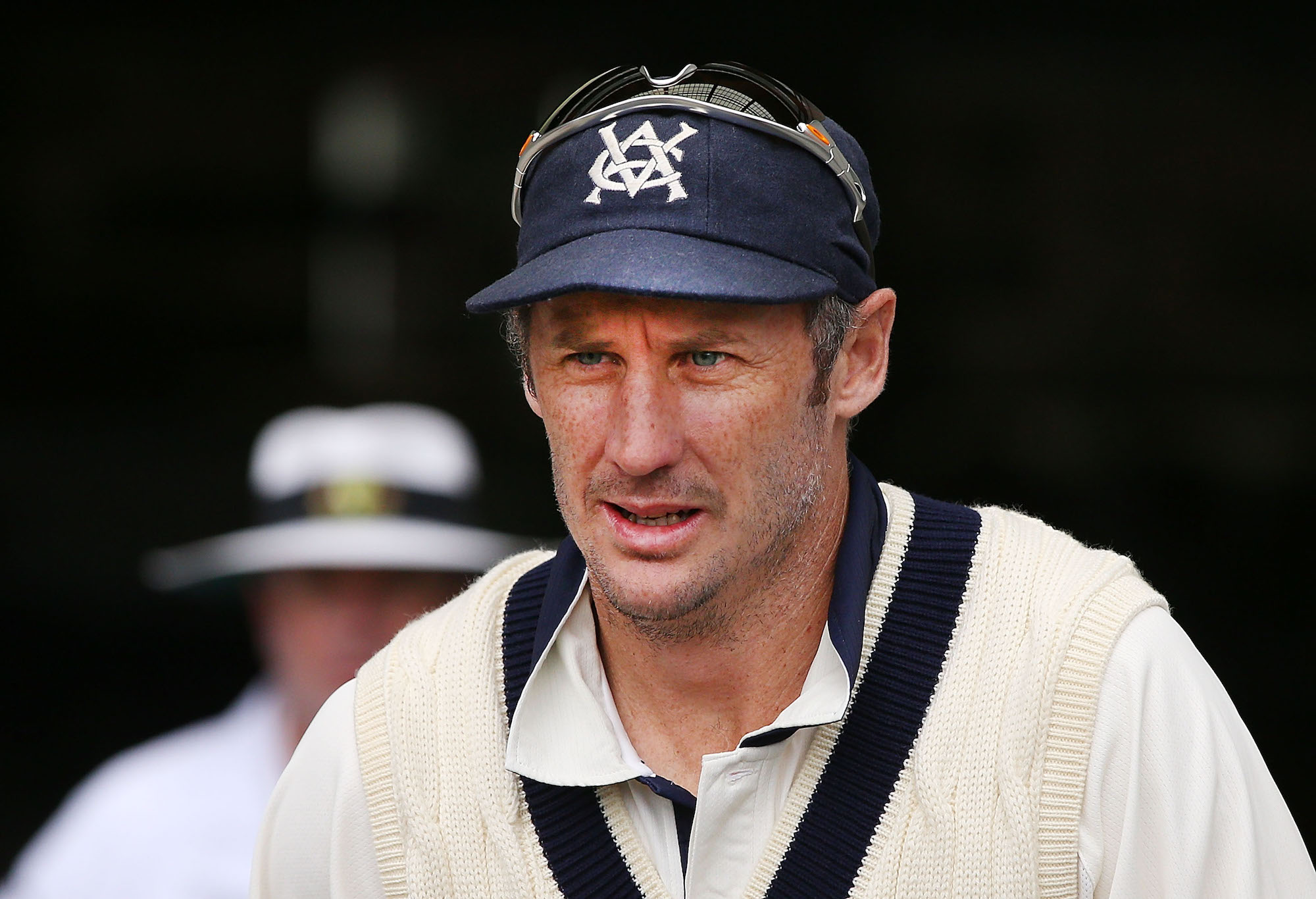
David Hussey was unlucky to never swap his Victorian cap for a baggy green. (Photo by Michael Dodge/Getty Images)
2013/14
Ben Cutting (QLD) vs VIC in Sydney.
Cutting came in with QLD struggling at 6/168 after 37 overs. 13 overs later he walked off with nine sixes, 98 runs from 48 balls and QLD at 305. He then took two wickets as Victoria fell 26 runs short.
David Warner (NSW) vs all comers.
Firstly against QLD in Sydney, Warner scored 139 from 126 balls out of a total of 253. The lack of support told as QLD chased down the total comfortably. Later in the season against Victoria, chasing a stiff target of 311, Warner hit 138 from 111 balls to help NSW to victory. The next time NSW met Victoria, Warner went even better, scoring a 197 from 141 balls (next best 46) to chase down 322 and breaking Jimmy Maher’s 2004 record for most runs in an innings.
2014/15
Josh Hazlewood (NSW) vs SA in Brisbane.
Hazlewood took 7/36 to restrict SA to 244, the best bowling figures since 2004 and still the third-best in the competition’s history.
Sam Rainbird (TAS) vs VIC in Brisbane.
Chasing 287, Victoria would still have been confident with a batting lineup including Quiney, Wade, Christian, White, Hussey and Stoinis. But Rainbird had other ideas, taking 5/29 including four of the top six batters as Tasmania won by 132 runs.
Moises Henriques (NSW) vs Victoria.
Henriques bowled nine tidy overs for 40 runs as Victoria scored an imposing 293. Henriques came in with NSW at 2/38 and scored 131 from 112 balls as they chased down the target with five overs to spare.
Nathan Reardon (QLD).
In consecutive matches against SA and Victoria, Reardon scored 75 from 35 balls and 52 from 27 balls as QLD exceeded 350 and comfortably won both matches.
Ben Dunk (TAS) vs QLD in Sydney.
Dunk scored the first-ever double-century in the competition’s history with 229 from 157 balls as Tasmania racked up 1/398 against QLD … and lost. Usman Khawaja (166) and Chris Hartley (142) put on a 280-opening run stand as they reached 400 with nearly three overs to spare.
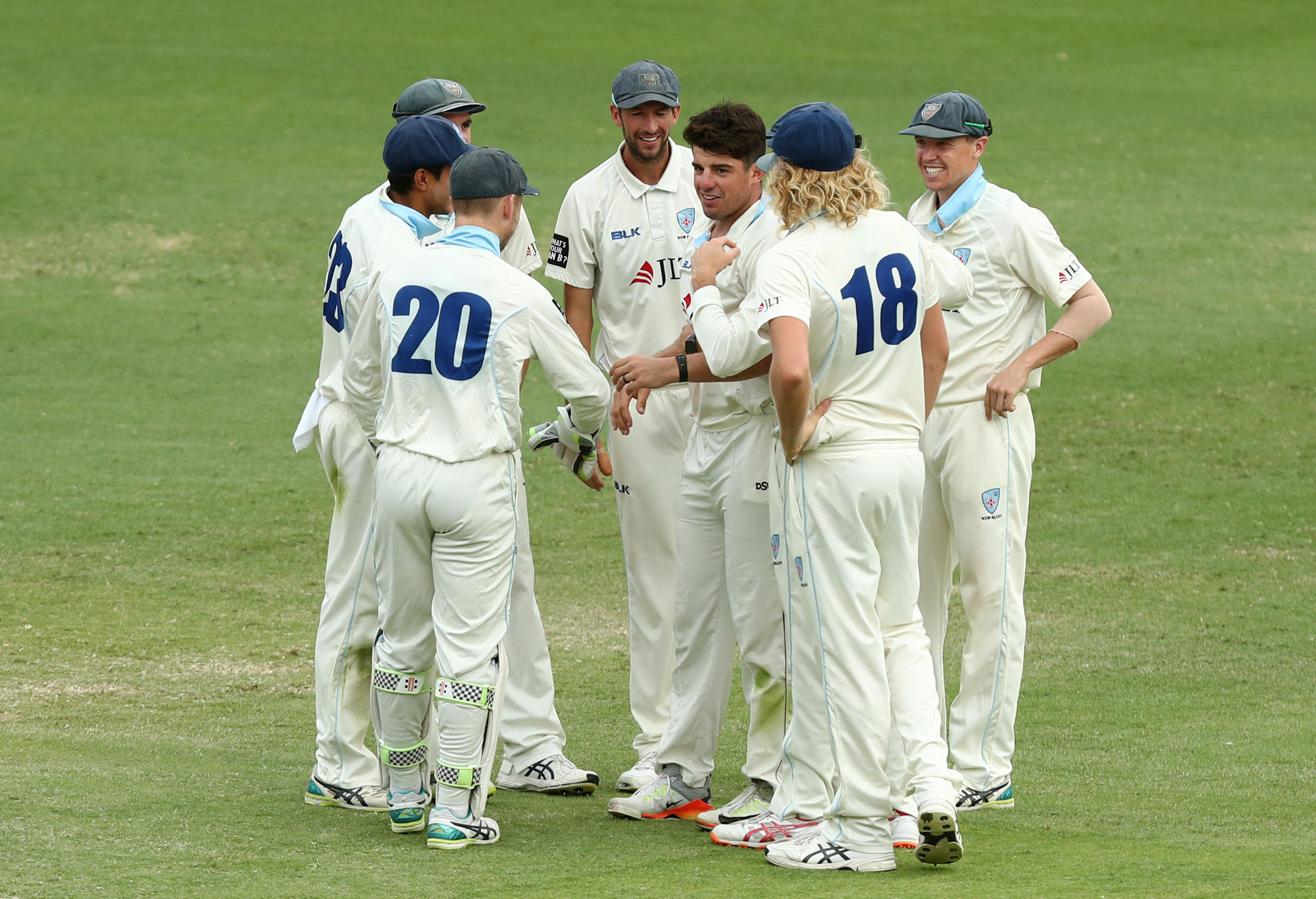
Moises Henriques (Photo by Chris Hyde/Getty Images)
2015/16
NSW vs CAXI in Sydney.
In a spectacularly dumb piece of scheduling, CAXI’s first-ever game was against a full-strength NSW side in Sydney. NSW scored 338 thanks to 108 from Nic Maddinson and 143 not out from 122 balls from Steve Smith, before a rampant Mitchell Starc took 6/25 to shoot out the youngsters for just 59 – a record 279-run defeat.
Travis Head (SA) vs WA in Sydney.
Head scored the competition’s second double century – 202 from 120 balls – as SA chased down WA’s 350 (Cameron Bancroft 176) with 3 overs to spare.
2016/17
CAXI vs. NSW.
A year after destroying the CAXI, NSW again looked to be cashing in with Moises Henriques bashing 164 from 135 balls as they scored 328. However, youngsters Ryan Gibson, Will Bosisto, Josh Inglis and Mathew Short put on a great chase ultimately falling just four runs short. Pat Cummins, in his first match for NSW in five years due to injury, took three wickets in eight balls to derail the chase.
Nic Maddinson (NSW) vs VIC in Sydney.
Chasing Victoria’s 309, Maddinson (112 from 89 balls and Daniel Hughes 122 from 121 balls) put on 192 for the second wicket, as NSW chased the target with three overs to spare.







































































































